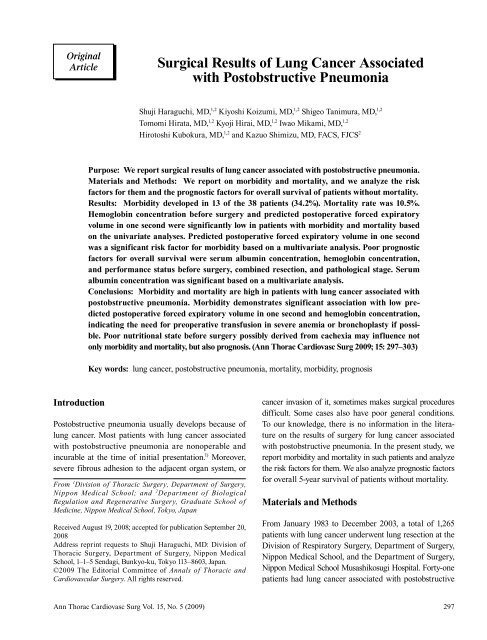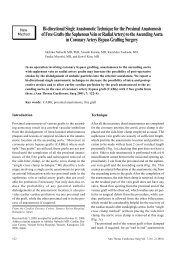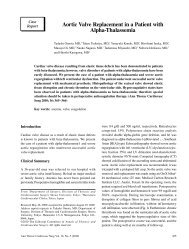Surgical Results of Lung Cancer Associated with ... - Atcs.jp
Surgical Results of Lung Cancer Associated with ... - Atcs.jp
Surgical Results of Lung Cancer Associated with ... - Atcs.jp
You also want an ePaper? Increase the reach of your titles
YUMPU automatically turns print PDFs into web optimized ePapers that Google loves.
Original<br />
Article<br />
<strong>Surgical</strong> <strong>Results</strong> <strong>of</strong> <strong>Lung</strong> <strong>Cancer</strong> <strong>Associated</strong><br />
<strong>with</strong> Postobstructive Pneumonia<br />
Shuji Haraguchi, MD, 1,2 Kiyoshi Koizumi, MD, 1,2 Shigeo Tanimura, MD, 1,2<br />
Tomomi Hirata, MD, 1,2 Kyoji Hirai, MD, 1,2 Iwao Mikami, MD, 1,2<br />
Hirotoshi Kubokura, MD, 1,2 and Kazuo Shimizu, MD, FACS, FJCS 2<br />
Purpose: We report surgical results <strong>of</strong> lung cancer associated <strong>with</strong> postobstructive pneumonia.<br />
Materials and Methods: We report on morbidity and mortality, and we analyze the risk<br />
factors for them and the prognostic factors for overall survival <strong>of</strong> patients <strong>with</strong>out mortality.<br />
<strong>Results</strong>: Morbidity developed in 13 <strong>of</strong> the 38 patients (34.2%). Mortality rate was 10.5%.<br />
Hemoglobin concentration before surgery and predicted postoperative forced expiratory<br />
volume in one second were significantly low in patients <strong>with</strong> morbidity and mortality based<br />
on the univariate analyses. Predicted postoperative forced expiratory volume in one second<br />
was a significant risk factor for morbidity based on a multivariate analysis. Poor prognostic<br />
factors for overall survival were serum albumin concentration, hemoglobin concentration,<br />
and performance status before surgery, combined resection, and pathological stage. Serum<br />
albumin concentration was significant based on a multivariate analysis.<br />
Conclusions: Morbidity and mortality are high in patients <strong>with</strong> lung cancer associated <strong>with</strong><br />
postobstructive pneumonia. Morbidity demonstrates significant association <strong>with</strong> low predicted<br />
postoperative forced expiratory volume in one second and hemoglobin concentration,<br />
indicating the need for preoperative transfusion in severe anemia or bronchoplasty if possible.<br />
Poor nutritional state before surgery possibly derived from cachexia may influence not<br />
only morbidity and mortality, but also prognosis. (Ann Thorac Cardiovasc Surg 2009; 15: 297–303)<br />
Key words: lung cancer, postobstructive pneumonia, mortality, morbidity, prognosis<br />
Introduction<br />
Postobstructive pneumonia usually develops because <strong>of</strong><br />
lung cancer. Most patients <strong>with</strong> lung cancer associated<br />
<strong>with</strong> postobstructive pneumonia are nonoperable and<br />
incurable at the time <strong>of</strong> initial presentation. 1) Moreover,<br />
severe fibrous adhesion to the adjacent organ system, or<br />
From 1 Division <strong>of</strong> Thoracic Surgery, Department <strong>of</strong> Surgery,<br />
Nippon Medical School; and 2 Department <strong>of</strong> Biological<br />
Regulation and Regenerative Surgery, Graduate School <strong>of</strong><br />
Medicine, Nippon Medical School, Tokyo, Japan<br />
Received August 19, 2008; accepted for publication September 20,<br />
2008<br />
Address reprint requests to Shuji Haraguchi, MD: Division <strong>of</strong><br />
Thoracic Surgery, Department <strong>of</strong> Surgery, Nippon Medical<br />
School, 1–1–5 Sendagi, Bunkyo-ku, Tokyo 113–8603, Japan.<br />
©2009 The Editorial Committee <strong>of</strong> Annals <strong>of</strong> Thoracic and<br />
Cardiovascular Surgery. All rights reserved.<br />
cancer invasion <strong>of</strong> it, sometimes makes surgical procedures<br />
difficult. Some cases also have poor general conditions.<br />
To our knowledge, there is no information in the literature<br />
on the results <strong>of</strong> surgery for lung cancer associated<br />
<strong>with</strong> postobstructive pneumonia. In the present study, we<br />
report morbidity and mortality in such patients and analyze<br />
the risk factors for them. We also analyze prognostic factors<br />
for overall 5-year survival <strong>of</strong> patients <strong>with</strong>out mortality.<br />
Materials and Methods<br />
From January 1983 to December 2003, a total <strong>of</strong> 1,265<br />
patients <strong>with</strong> lung cancer underwent lung resection at the<br />
Division <strong>of</strong> Respiratory Surgery, Department <strong>of</strong> Surgery,<br />
Nippon Medical School, and the Department <strong>of</strong> Surgery,<br />
Nippon Medical School Musashikosugi Hospital. Forty-one<br />
patients had lung cancer associated <strong>with</strong> postobstructive<br />
Ann Thorac Cardiovasc Surg Vol. 15, No. 5 (2009)<br />
297
Haraguchi et al.<br />
pneumonia in their medical records, but 3 were excluded<br />
from the present study because <strong>of</strong> the lack <strong>of</strong> a detailed<br />
clinical background. Therefore 38 patients, including 33<br />
males and 5 females, were analyzed in the present study.<br />
All patients were treated <strong>with</strong> antibiotics after a diagnosis<br />
<strong>of</strong> postobstructive pneumonia. The mean interval<br />
between the onset <strong>of</strong> postobstructive pneumonia and surgery<br />
was 45 days (range, 4–111 days). Thirty-four patients<br />
underwent lung resection by posterolateral thoracotomy<br />
and 4 by video-assisted thoracoscopic surgery. Fourteen<br />
patients (40%) underwent pneumonectomy, 9 (29%)<br />
underwent bilobectomy, 8 (25%) underwent lobectomy,<br />
and 2 (5%) underwent segmentectomy. A bronchoplasty<br />
was performed on 5 patients (sleeve bilobectomy: 2;<br />
sleeve lobectomy: 2; and sleeve pneumonectomy: 1).<br />
Combined resection was performed on the pericardium<br />
in 6 patients, the chest wall in 4, the truncus <strong>of</strong> the pulmonary<br />
artery, left atrium, and aorta in 2, and the diaphragm and<br />
innominate vein in 1. Nineteen patients (50%) had pathological<br />
stage III disease, 12 (32%) had stage I disease, 6<br />
(16%) had stage II disease, and 1 (2%) had stage IV disease.<br />
Twenty-seven patients (71%) had squamous cell carcinoma,<br />
8 (20%) had adenocarcinoma, 1 (3%) had large cell carcinoma,<br />
1 (3%) had carcinoid, and 1 (3%) had mucoepidermoid<br />
carcinoma.<br />
Anemia was defined according to World Health Organization<br />
(WHO) criteria as hemoglobin concentration<br />
less than 13.0 g/dl in a male and less than 12.0 g/dl in a<br />
female. Twenty-five patients (66%) had anemia before<br />
surgery, but only 4 had hemoptyses and hemosputa.<br />
Twenty-four <strong>of</strong> 25 anemic patients had normocytic normochromic<br />
anemia, and 1 had microcytic hypochlomic<br />
anemia. The mean hemoglobin concentration <strong>of</strong> all<br />
patients <strong>with</strong> postobstructive pneumonia was 12.4 g/dl<br />
(range, 7.9–17.3 g/dl). No patients were transfused before<br />
surgery.<br />
The postoperative pulmonary functions were predicted<br />
according to a simplified system, which we developed<br />
using plain chest roentgenograms <strong>of</strong> patients <strong>with</strong> primary<br />
lung cancer. 2) The predicted postoperative forced<br />
expiratory volume in 1 second (ppoFEV 1.0 ) is (42–R)/(42–<br />
T) × preoperative FEV 1.0 , where R is the number <strong>of</strong><br />
subsegments scheduled for lung resection and T is the<br />
number <strong>of</strong> subsegments showing atelectasis or postobstructive<br />
pneumonia. 2)<br />
The lung cancers <strong>of</strong> all patients were staged pathologically<br />
according to the International Union against <strong>Cancer</strong><br />
system. 3)<br />
Mortality was defined as death occurring during the<br />
hospitalization period following surgery. 4) Morbidity in<br />
this study was defined as complications that occurred<br />
during the hospitalization period after surgery 4) and<br />
included pneumonia, respiratory failure necessitating<br />
mechanical ventilation for more than 48 hours, bronchopulmonary<br />
artery fistula, bronchopleural fistula<br />
(BPF), a prolonged air leakage <strong>of</strong> more than 7 days from<br />
the chest drain, acute myocardial infarction, and cerebral<br />
infarction.<br />
Statistical analyses were performed between patients<br />
<strong>with</strong> and <strong>with</strong>out morbidity and between patients <strong>with</strong><br />
and <strong>with</strong>out mortality, using the StatView 5.0J s<strong>of</strong>tware<br />
package (SAS Institute, Inc., Cary, NC) and SPSS 10.0<br />
s<strong>of</strong>tware package (SPSS, Inc., Chicago, IL). Univariate<br />
analyses between the groups were performed by means<br />
<strong>of</strong> unpaired two-tailed t tests or the chi-square test, using<br />
age, sex, body mass index (BMI), smoking history<br />
(smoker and ex-smoker vs. nonsmoker), number <strong>of</strong> cigarette<br />
pack-years, serum albumin concentration and hemoglobin<br />
concentration before surgery, performance status (PS)<br />
before surgery (PS 0, 1 vs. 2, 3), and partial pressure <strong>of</strong><br />
oxygen and carbon dioxide at pulmonary artery before<br />
surgery (PaO 2 and PaCO 2 ), ppoFEV 1.0 , duration <strong>of</strong> surgery,<br />
volume <strong>of</strong> blood loss, operative procedures (pneumonectomy<br />
or bilobectomy vs. lobectomy or segmentectomy), combined<br />
resection <strong>of</strong> other organs, pathological stage (stage I or II<br />
vs. stage III or IV), and histological type <strong>of</strong> lung cancer<br />
(squamous cell carcinoma vs. others). Multivariate logistic<br />
regression tests were performed <strong>with</strong> significant risk factors<br />
identified <strong>with</strong> univariate analyses.<br />
For statistical analyses <strong>of</strong> prognostic factors for the<br />
overall survival <strong>of</strong> patients <strong>with</strong>out mortality, we partitioned<br />
the patients by age (above or below the median <strong>of</strong><br />
63 years), sex, BMI (above or below the median <strong>of</strong> 22.7<br />
kg/m 2 ), number <strong>of</strong> cigarette pack-years (above or below<br />
the median <strong>of</strong> 45), serum albumin concentration (above<br />
or below the median <strong>of</strong> 3.6 g/dl), and hemoglobin concentration<br />
(above or below the median <strong>of</strong> 12.5 g/dl)<br />
before surgery, PS before surgery (0, 1 vs. 2, 3), partial<br />
pressure <strong>of</strong> oxygen (above or below the median <strong>of</strong> 83.6<br />
mmHg), and carbon dioxide (above or below the median<br />
<strong>of</strong> 39.0 mmHg) at pulmonary artery before surgery (PaO 2<br />
and PaCO 2 ), ppoFEV 1.0 (above or below the median <strong>of</strong> 1.4<br />
L), duration <strong>of</strong> surgery (above or below the median <strong>of</strong><br />
330 minutes), volume <strong>of</strong> blood loss (above or below the<br />
median <strong>of</strong> 607.5 ml), operative procedures (pneumonectomy<br />
or bilobectomy vs. lobectomy or segmentectomy),<br />
combined resection <strong>of</strong> other organs, pathological stage<br />
(stage I or II vs. stage III or IV), and histological type <strong>of</strong><br />
298<br />
Ann Thorac Cardiovasc Surg Vol. 15, No. 5 (2009)
<strong>Surgical</strong> <strong>Results</strong> <strong>of</strong> <strong>Lung</strong> <strong>Cancer</strong> <strong>Associated</strong> <strong>with</strong> Postobstructive Pneumonia<br />
Table 1. Clinical characteristics <strong>of</strong> 13 patients <strong>with</strong> lung cancer associated <strong>with</strong> postobstructive pneumonia developing morbidity<br />
Patient Age/Sex Stage Pathology<br />
Tumor<br />
Procedures<br />
Albumin Hg PpoFEV 1.0<br />
PS Morbidity<br />
Survival<br />
No. location (g/dl) (g/dl) (L) (M)<br />
1 72M III Ad Rt. B2 Bilobectomy 2.4 10.7 0.96 2 Pneumonia 22D<br />
2 65F III Sq Rt. B1 Sleeve bilobectomy 2.4 8.6 0.58 3 Broncho-PA fistula 1D<br />
3 66M II Sq Rt. B6 Bilobectomy 4.0 12.6 1.39 1 AL and AMI 0.5D<br />
4 54M II Sq Rt. B6 Bilobectomy 3.7 10.1 1.19 2 Bilateral pneumonia 1.8D<br />
5 63M III Sq BUD Pneumonectomy 2.9 10.3 1.60 2 Pyothorax 8D<br />
6 47M III Sq Rt. IB Pneumonectomy 3.1 10.8 1.46 3 BPF 37D<br />
7 83M III Sq Rt. B10 Lobectomy 3.0 7.9 0.73 3 Pneumonia and CI 0.4D<br />
8 73M I Sq Lt. B9 Lobectomy 4.4 16.0 0.90 0 Pneumonia 60A<br />
9 57M III Sq BUD Pneumonectomy 3.5 11.2 1.48 1 BPF 41A<br />
10 68M I Sq Rt. B6 Bilobectomy 3.6 11.5 1.30 1 BPF 20A<br />
11 76F I Sq Lingula Lobectomy 3.9 11.5 1.22 1 Pneumonia 60A<br />
12 47F III Ad Lt. B1 + 2 Pneumonectomy 4.1 10.5 1.40 3 Pneumonia 10D<br />
13 61M II Sq Lt. B6 Lobectomy 3.6 13.1 0.76 2 Pneumonia 18A<br />
Hg, hemoglobin; ppoFEV 1.0 , predicted postoperative forced expiratory volume in 1 second; M, male; F, female; Ad, adenocarcinoma;<br />
Sq, squamous cell carcinoma; Rt, right; B, bronchus; BUD, bronchus <strong>of</strong> upper division; IB, intermediate bronchus; Lt, left; AL, air<br />
leakage; AMI, acute myocardial infarction; BPF, bronchopleural fistula; CI, cerebral infarction; D, dead; A, alive.<br />
lung cancer (squamous cell carcinoma vs. others). For the<br />
univariate analyses, the overall survival for subgroups<br />
described above was statistically analyzed using Kaplan-<br />
Meier estimated survival curves, and the significance <strong>of</strong><br />
the difference was analyzed by the log-rank test. For a<br />
multivariate analysis, the Cox proportional hazards model<br />
was used to examine the effect <strong>of</strong> significant risk factors<br />
based on the univariate analyses on survival. A p
Haraguchi et al.<br />
Table 2. Clinical characteristics <strong>of</strong> patients <strong>with</strong> or <strong>with</strong>out morbidity<br />
With morbidity Without morbidity P value<br />
Number <strong>of</strong> patients 13 25<br />
Age a 64.0 ± 11.0 62.2 ± 14.3 0.6872<br />
Sex<br />
Male 10 (77) 23 (92)<br />
Female 3 (23) 2 (8) 0.1921<br />
Number <strong>of</strong> cigarette pack-years a 53.4 ± 34.3 54.5 ± 36.8 0.9270<br />
Smoker or ex-smoker 12 (92) 23 (92)<br />
Nonsmoker 1 (8) 2 (8) 0.9734<br />
Serum albumin (g/dl) a 3.4 ± 0.6 3.7 ± 0.4 0.0860<br />
Hemoglobin (g/dl) a 11.2 ± 2.1 13.0 ± 1.7 0.0071*<br />
BMI (kg/m 2 ) a 21.2 ± 3.2 22.9 ± 2.7 0.0643<br />
PaO 2 (mmHg) a 81.7 ± 19.0 83.5 ± 11.4 0.7128<br />
PaCO 2 (mmHg) a 39.8 ± 4.2 40.0 ± 2.9 0.9244<br />
PpoFEV 1.0 (L) a 1.1 ± 0.3 1.5 ± 0.4 0.0056*<br />
Performance status<br />
0, 1 7 (54) 20 (80)<br />
2, 3 6 (46) 5 (20) 0.0917<br />
Operative procedures<br />
Pneumonectomy 4 (31) 11 (44)<br />
Other 9 (69) 14 (56) 0.4286<br />
Duration <strong>of</strong> surgery (min) a 380.6 ± 122.1 348.4 ± 111.7 0.4192<br />
Volume <strong>of</strong> blood loss (ml) a 1064.2 ± 1091.3 1024.0 ± 1233.5 0.9217<br />
Combined resection 4 (31) 9 (36) 0.7471<br />
Bronchoplasty 3 (23) 2 (8) 0.1921<br />
Pathological stage <strong>of</strong> lung cancer<br />
I, II 5 (38) 12 (48)<br />
III, IV 8 (62) 13 (52) 0.5748<br />
Histological type <strong>of</strong> lung cancer<br />
Squamous cell carcinoma 10 (77) 17 (68)<br />
Others 3 (23) 8 (32) 0.5650<br />
BMI, body mass index; PaO 2 , partial pressure <strong>of</strong> oxygen at pulmonary artery; PaCO 2 , partial pressure <strong>of</strong><br />
carbon dioxide at pulmonary artery; ppoFEV 1.0 , predicted postoperative forced expiratory volume in 1<br />
second; *, statistical significance.<br />
a<br />
Data are shown as mean ± standard deviation; percentage given in parentheses.<br />
bidity and mortality after surgery for lung cancer in<br />
Japan. 5) However, the present study revealed that surgery<br />
for lung cancer associated <strong>with</strong> postobstructive pneumonia<br />
still had high morbidity and mortality, and that ppoFEV 1.0<br />
was the significant risk factor for morbidity based on a<br />
multivariate analysis. <strong>Lung</strong> cancer located at the proximal<br />
bronchus usually needs major lung resection, and in the<br />
present study, pneumonectomy and bilobectomy were performed<br />
in 40% and 29% <strong>of</strong> the patients, respectively. The<br />
morbidity and mortality in the pneumonectomy group<br />
were equivalent or higher than those in the lobectomy <strong>with</strong><br />
bronchoplasty. 6–9) Although it is recognized that patients<br />
<strong>with</strong> pneumonectomy most likely have more advanced stage<br />
disease, long-term survival and local control are significantly<br />
better when complete resection can be achieved by sleeve<br />
lobectomy. 8,9) We performed bronchoplastic procedures in<br />
5 cases. Recently, therapeutic bronchoscopy has been<br />
used for relieving large airway obstructions caused by<br />
tumors. 1,10) It is reported to be a complementary tool in<br />
the combined bronchoscopic and surgical management <strong>of</strong><br />
malignant airway obstruction before curative lung surgery<br />
and may permit parenchyma-sparing surgery. 11) Postobstructive<br />
pneumonia possibly could be improved early if<br />
the obstructed bronchus is recanalized. Therapeutic<br />
bronchoscopy could not only restore FEV 1.0 , but it makes<br />
PS before surgery better. Direct intratumoral injection<br />
<strong>with</strong> 5-fluorouracil for tumor regression is reported to<br />
reduce the size <strong>of</strong> tumors in most cases and increase the<br />
diameter <strong>of</strong> the airway lumen. 12) Future studies using various<br />
therapeutic modalities are expected to clarify the<br />
effectiveness in reducing morbidity and mortality after<br />
surgery for patients <strong>with</strong> lung cancer associated <strong>with</strong> post-<br />
300<br />
Ann Thorac Cardiovasc Surg Vol. 15, No. 5 (2009)
Groups<br />
<strong>Surgical</strong> <strong>Results</strong> <strong>of</strong> <strong>Lung</strong> <strong>Cancer</strong> <strong>Associated</strong> <strong>with</strong> Postobstructive Pneumonia<br />
Table 3. Statistical analyses <strong>of</strong> prognostic factors for overall survival <strong>of</strong> patients <strong>with</strong>out mortality<br />
Overall survival rates (%)<br />
at 1 2 3 4 5 years<br />
P value (log-rank)<br />
Age
Haraguchi et al.<br />
obstructive pneumonia.<br />
Preoperative hemoglobin concentration was the other<br />
risk factor for morbidity. Twenty-five patients (66%) had<br />
anemia before surgery. Twenty-four <strong>of</strong> them had normocytic<br />
normochromic anemia and 1 patient had microcytic<br />
hypochromic anemia. Only 4 patients had hemoptyses<br />
and hemosputa. Twenty-one patients had exacerbation <strong>of</strong><br />
general conditions because <strong>of</strong> postobstructive pneumonia<br />
and lung cancer. There were no differences in volume <strong>of</strong><br />
blood loss or transfusion during surgery between patients<br />
<strong>with</strong> and <strong>with</strong>out morbidity (data not shown). Even<br />
patients <strong>with</strong> severe anemia were not transfused before<br />
surgery in the present study. It is suggested that a thorough<br />
treatment <strong>of</strong> postobstructive pneumonia <strong>with</strong> the<br />
antibiotics and transfusion for patients <strong>with</strong> severe anemia<br />
early before surgery are necessary for making<br />
general conditions better and reducing morbidity and<br />
mortality.<br />
BPF developed most frequently after surgery in<br />
patients <strong>with</strong> lung cancer associated <strong>with</strong> postobstructive<br />
pneumonia. Three developed after pneumonectomy (2<br />
after right pneumonectomy and 1 after left). We previously<br />
analyzed the risk factors predisposing to postpneumonectomy<br />
BPF in patients <strong>with</strong> lung cancer and<br />
found that right pneumonectomy, preoperative infection,<br />
and metastasis to a subcarinal lymph node were the risk<br />
factors for postpneumonectomy BPF (PBPF). 13) We further<br />
reanalyzed the risk factors for PBPF in a larger<br />
series, adding some risk factors reported recently, and<br />
found that preoperative infection, right pneumonectomy,<br />
and pathological N2 and N3 significantly contributed to<br />
the development <strong>of</strong> PBPF. 14) The lung is a common site <strong>of</strong><br />
infection in patients <strong>with</strong> lung cancer, and postobstructive<br />
pneumonia, lung abscess, and occasionally empyema <strong>of</strong><br />
mixed bacterial etiology are frequent. 15) Bronchial stump<br />
coverage <strong>with</strong> pedicled thymus and pericardial flaps are<br />
reported to be effective in preventing BPF. 16,17) Treatment<br />
<strong>with</strong> the antibiotics and bronchial stump coverage are<br />
expected to clarify effectiveness in preventing BPF in<br />
patients <strong>with</strong> lung cancer associated <strong>with</strong> postobstructive<br />
pneumonia. 13,14)<br />
In the present study, low serum albumin concentration,<br />
hemoglobin concentration, PS before surgery, combined<br />
resection <strong>of</strong> other organs, and an advanced pathological<br />
stage were poor prognostic factors. A combined resection<br />
was performed in all cases because <strong>of</strong> cancer invasion to<br />
the adjacent organ system. Combined resection <strong>of</strong> other<br />
organs and an advanced pathological stage were reported<br />
to have poor prognosis. 18) Busch and his colleagues<br />
reported that combined resection involving chest wall,<br />
poor nutritional status as measured by a history <strong>of</strong> weight<br />
loss and preoperative serum albumin levels, and the use<br />
<strong>of</strong> neoadjuvant chemotherapy were associated <strong>with</strong> an<br />
increased risk <strong>of</strong> any pulmonary complication, but they<br />
did not comment whether these risk factors influenced<br />
prognosis. 19) Combined resection <strong>of</strong> other organs, low<br />
serum albumin concentration, and PS before surgery<br />
were not significant risk factors for morbidity and mortality,<br />
and low serum albumin concentration, hemoglobin concentration,<br />
and PS before surgery were poor prognostic<br />
factors in the present study. It is suggested that low serum<br />
albumin concentration, hemoglobin concentration, and<br />
PS before surgery were caused mainly because <strong>of</strong><br />
cachexia more than by postobstructive pneumonia, and<br />
compromised immunology against lung cancer led to<br />
poor prognosis.<br />
References<br />
1. Mehta RM, Cutaia M. The role <strong>of</strong> interventional pulmonary<br />
procedures in the management <strong>of</strong> post-obstructive<br />
pneumonia. Curr Infect Dis Rep 2006; 8: 207–14.<br />
2. Haraguchi S, Koizumi K, Hatori N, Akiyama H,<br />
Mikami I, et al. Prediction <strong>of</strong> the postoperative pulmonary<br />
function and complication rate in elderly patients.<br />
Surg Today 2001; 31: 860–5.<br />
3. UICC. <strong>Lung</strong> and pleural tumours. In: Sobin LH, Wittekind<br />
Ch, eds.; UICC TNM Classification <strong>of</strong> Malignant<br />
Tumours. 5th ed., New York: John Wiley & Sons, Inc.,<br />
1997; pp 91–100.<br />
4. [No authors listed] Society <strong>of</strong> Thoracic Surgeons.<br />
Guidelines for data reporting and nomenclature for the<br />
Annals <strong>of</strong> Thoracic Surgery. Ann Thorac Surg 1988;<br />
46: 260–1.<br />
5. Kazui T, Wada H, Fujita H; Japanese Association for<br />
Thoracic Surgery Committee <strong>of</strong> Science. Thoracic and<br />
cardiovascular surgery in Japan during 2003: annual<br />
report by The Japanese Association for Thoracic Surgery.<br />
Jpn J Thorac Cardiovasc Surg 2005; 9: 517–36.<br />
6. Yoshino I, Yokoyama H, Yano T, Ueda T, Takai E, et<br />
al. Comparison <strong>of</strong> the surgical results <strong>of</strong> lobectomy<br />
<strong>with</strong> bronchoplasty and pneumonectomy for lung cancer.<br />
J Surg Oncol 1997; 64: 32–5.<br />
7. Suen HC, Meyers BF, Guthrie T, Pohl MS, Sundaresan<br />
S, et al. Favorable results after sleeve lobectomy or<br />
bronchoplasty for bronchial malignancies. Ann Thorac<br />
Surg 1999; 67: 1557–62.<br />
8. Deslauriers J, Grégoire J, Jacques LF, Piraux M,<br />
Guojin L, et al. Sleeve lobectomy versus pneumonectomy<br />
for lung cancer: a comparative analysis <strong>of</strong> survival and<br />
sites or recurrences. Ann Thorac Surg 2004; 77: 1152–6.<br />
9. Sekine Y, Saitoh Y, Chiyo M, Yasufuku K, Iyoda A, et<br />
al. Characteristics <strong>of</strong> tumor extension requiring bron-<br />
302<br />
Ann Thorac Cardiovasc Surg Vol. 15, No. 5 (2009)
<strong>Surgical</strong> <strong>Results</strong> <strong>of</strong> <strong>Lung</strong> <strong>Cancer</strong> <strong>Associated</strong> <strong>with</strong> Postobstructive Pneumonia<br />
choplasty and pneumonectomy in patients <strong>with</strong> lung<br />
cancer and positive bronchoscopic findings. Surg<br />
Today 2006; 36: 491–8.<br />
10. Lee P, Kupeli E, Mehta AC. Therapeutic bronchoscopy<br />
in lung cancer. Laser therapy, electrocautery, brachytherapy,<br />
stents, and photodynamic therapy. Clin Chest<br />
Med 2002; 23: 241–56.<br />
11. Chhajed PN, Eberhardt R, Dienemann H, Azzola A,<br />
Brutsche MH, et al. Therapeutic bronchoscopy interventions<br />
before surgical resection <strong>of</strong> lung cancer. Ann<br />
Thorac Surg 2006; 81: 1839–43.<br />
12. Celikoglu F, Celikoglu SI. Intratumoural chemotherapy<br />
<strong>with</strong> 5-fluorouracil for palliation <strong>of</strong> bronchial cancer<br />
in patients <strong>with</strong> severe airway obstruction. J Pharm<br />
Pharmacol 2003; 55: 1441–8.<br />
13. Haraguchi S, Koizumi K, Gomibuchi M, Matsushima<br />
S, Masaki Y, et al. Analysis <strong>of</strong> risk factors for development<br />
<strong>of</strong> bronchopleural fistula after pneumonectomy<br />
for lung cancer. Nippon Kyobu Geka Gakkai Zasshi<br />
1996; 44: 1835–9. (in Jpse. <strong>with</strong> Engl. abstr.)<br />
14. Haraguchi S, Koizumi K, Hioki M, Hirata T, Hirai K,<br />
et al. Analysis <strong>of</strong> risk factors for postpenumonectomy<br />
bronchopleural fistulas in patients <strong>with</strong> lung cancer. J<br />
Nippon Med Sch 2006; 73: 314–9.<br />
15. Rolston KV. The spectrum <strong>of</strong> pulmonary infections in<br />
cancer patients. Curr Opin Oncol 2001; 13: 218–23.<br />
16. Infante MV, Alloisio M, Balzarini L, Cariboni U, Testori<br />
A, et al. Protection <strong>of</strong> right pneumonectomy bronchial<br />
sutures <strong>with</strong> a pedicled thymus flap. Ann Thorac Surg<br />
2004; 77: 351–3.<br />
17. Taghavi S, Marta GM, Lang G, Seebacher G, Winkler<br />
G, et al. Bronchial stump coverage <strong>with</strong> a pedicled<br />
pericardial flap: an effective method for prevention <strong>of</strong><br />
postpneumonectomy bronchopleural fistula. Ann Thorac<br />
Surg 2005; 79: 284–8.<br />
18. Goldstraw P, Crowley J, Chansky K, Giroux DJ,<br />
Groome PA, et al. The IASLC <strong>Lung</strong> <strong>Cancer</strong> Staging<br />
Project: proposals for the revision <strong>of</strong> the TNM stage<br />
groupings in the forthcoming (seventh) edition <strong>of</strong> the<br />
TNM classification <strong>of</strong> malignant tumours. J Thorac<br />
Oncol 2007; 2: 706–14.<br />
19. Busch E, Verazin G, Antkowiak JG, Driscoll D, Takita<br />
H. Pulmonary complications in patients undergoing<br />
thoracotomy for lung carcinoma. Chest 1994; 105:<br />
760–6.<br />
Ann Thorac Cardiovasc Surg Vol. 15, No. 5 (2009) 303








